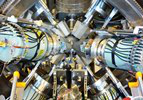Speaker
Prof.
Klaus Jungmann
(University of Groningen)
Description
The observation Atomic Parity Violation in atoms has been crucial for the acceptance of the Standard Model as a general theory in physics. Today APV has been measured best in Cs atoms and provides for precise value of the weak mixing (Weinberg) angle at the lowest energies with sub % accuracy. A deviation of this value from predictions based on measurements in all accessible ranges of momentum transfer would clearly indicate New Physics outside the present Standard Model. Possibilities of such physics could be for example Z’ bosons heavier than they can be limited at LHC or dark Z bosons at very low energies. It appears that APV provides for an excellent opportunity to observe these dark Z bosons or set the lowest mass bounds on them. For the extraction of the weak mixing angle from APV measurements precise calculations of atomic structure are indispensable. They are by far best possible for alkali atoms and alkali-earth ions. The weak effects scale stronger than Z3, where Z is the nuclear charge of an atom. Therefore heavy atoms or ions such as Fr or Ra+ are well suited for such research. In Groningen a Ra+ project using a single trapped ion is under way. It uses Ba+ as a non-radioactive precursor. It appears that for atomic theory the knowledge of the absolute value of the nuclear radius will become the limiting factor in the theoretical description of the ion. Muonic atom spectroscopy has a high potential to provide the required nuclear parameters.
Author
Prof.
Klaus Jungmann
(University of Groningen)

